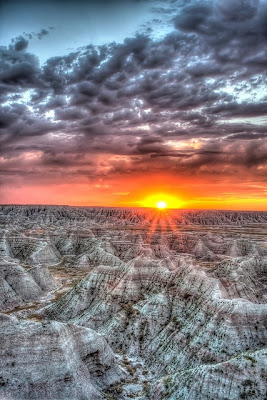Physical geography of Badlands National Park
Badlands National Park has an arid steppe climate and is
located in the Southwest part of South Dakota. Some of the most recognizable
geographic landforms in Badlands National Park are Buttes, Pinnacles, and
Spires. The main geographical factor that has helped shape the park into its
current state is erosion. Erosion is the transfer of weathered material from
one location to another and can happen at many different rates. The estimated rate
of erosion in Badlands National Park is about one inch per year. There are
several different ways for erosion to shape and change an areas physical
geography. One way is by physical weathering, this process is the
disintegration of rocks or minerals by a physical or mechanical process. Another process that helps erosion is salt
weathering; this occurs when salt crystals get wet and expands, often forming
cavernous erosion in rocks and minerals. Another cause of erosion is a process
of weathering involving sand and wind; however this is usually not as damaging
as other forms of weathering. The main process responsible in the erosion of
Badlands National Park is physical weathering, with water being the strongest force.
Possible physical landscape of Badlands National Park in
1000 years
I hypothesize that in 1000 years the landscape of Badlands
National Park will look similar to today’s landscape but with more extreme
erosion and a drier climate. One way to support this hypothesis is that
currently Badlands is eroding at one inch per year and will continue to erode
at this rate. Also because the Park is in a rain shadow from the Rocky Mountains
the climate will remain dry.
Possible physical landscape of Badlands National Park in
10,000 years
At the rate that Badlands National Park is eroding any
current landscape features would be unrecognizable in 10,000 years. This is
because over 800 feet would be eroded in 10,000 years at the current rate, this
does not bring into account possible catastrophic events. So it is possible that
another major volcanic eruption could take place in the Yellowstone area and
ash from that could add to the Park.
Possible physical landscape of Badlands National Park in
1,000,000 years
It is hard to hypothesize the possible state that the
landscape of Badlands National Park could be at in one million years. But using
the uniformitarianism concept that what has happened in the past will happen
again in the future. I believe that it is possible of a low lying sea or ocean
in the area of Badlands National Park. This is because there is fossil evidence
that there was a low lying sea during the Cretaceous period covering parts of South Dakota and
much of mid-America.
This image depicts how the US looked during the Cretaceous
period and could possibly look if another low lying ocean covered middle
America in the distant future. Image credit:
Summarization of current and future landscapes of Badlands
National Park
Overall I believe Badlands National Park will continue to
erode at the current rate and will remain an arid climate. The only exceptions
to this are catastrophic events that are hard to predict and could change the
geography of the park.
This image is a panoramic view of the Badlands and is a good depiction of the eroded landscape that makes up the majority of the physical geography there. Image credit: http://parks.mapquest.com/national-parks/badlands-national-park/















